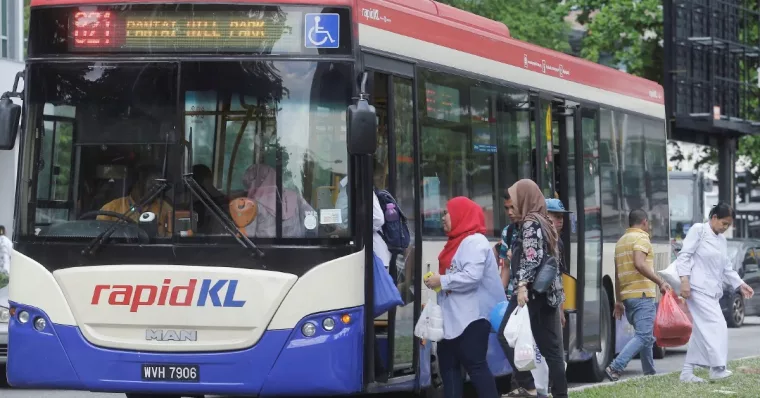
Like thousands of other Malaysians living in the Klang Valley, I spend far too long stuck in traffic jams.
It’s basically a daily event at this point. I step out of my office, step into my car and slam headfirst into a jam the moment I leave the parking lot. On Friday evenings, I actually try to stay in the office for an hour or two more than usual in the hopes that the traffic will have calmed down a bit by the time I leave.
Things weren’t so bad back before the pandemic, but over the past few months the situation has gotten worse and worse. Nowadays, I can spend nearly an hour stuck in traffic before reaching home.
But last week, I noticed something strange. The traffic jam seemed to be improving. Instead of taking an hour, now it “only” takes 45 minutes for me to get home.
So What Changed?
Given that I can reach work in less than 10 minutes if the road is clear, 45 minutes is still way too long. But it’s still a noticeable improvement.
But what could have caused this change? Did some new highway open? Are people switching back to work from home? Have ordinary Malaysians decided to just sleep in their offices overnight rather than brave the KL traffic?
The answer: free LRT rides.
Yes, I’m Being Serious

On 16 June 2022, Prime Minister Ismail Sabri Yaakob announced that all transportation services under RapidKL would be free of charge from 16 June to 15 July.
This includes MRT, LRT, Bus Rapid Transit (BRT), monorail and RapidKL buses.
Officially, this is being done to celebrate the official opening of Phase 1 of the MRT Putrajaya Line and encourage more Malaysians to use public transportation.
“This is one of the main agendas of the government — to revive and stabilise the country’s economy and ensure the well-being of the Malaysian Family,” he said.
“I hope members of the Malaysian Family will take this advantage to try using public transport by parking their cars at the Park N’ Ride facility and take a ride on the MRT.”
So I Decided to Try It Myself

Regardless of the reasons, many Klang Valley residents have welcomed this news with open arms. To learn more about this new initiative, I decided to try it out for myself.
Since I hadn’t ridden on the LRT line for a long time, I was a bit worried about what to expect. However, when I first reached the station everything seemed to look perfectly normal. To get on a train, you can simply collect an entry token at the counter. Alternatively, you can just flash your Touch n Go card or monthly pass like normal (no money is deducted during this time period).
The problems began when I reached KL Sentral.
As anyone who’s taken the LRT before will know, rush hour is rough. And on this day, it seemed to be even tougher than normal. To be fair, I haven’t taken the train very often since the pandemic started. But it was still a shock to see just how many people were crowded onto the platform.
In fact, the crowd was so bad that I decided to skip the first train.
“I’ll just take the next train,” I thought. Looking at all the people crammed into the carriage like sardines, I remembered why I was so glad to start driving to work instead.
The second train arrived five minutes later. It was just as cramped, so I once again decided to wait for the next one. By now, the platform crowd had thinned considerably, so I figured that the third train wouldn’t be too stuffed. Also, I was starting to worry that I’d be late for work.
And so as the doors closed and the train peeled out of the station, I stepped back and waited. And waited. And waited some more…
15 minutes later, the third train finally arrived. I don’t know why it had taken so much longer to arrive, but at this point I didn’t have time to spare. I rushed on board along with everyone else, then spent the next 40 minutes or so getting uncomfortably close to all my neighbours.
By the time I finally reached my destination, I was officially late for work. As if to add insult to injury, rain was pouring down. Protected with nothing more than a flimsy little umbrella, I was thoroughly soaked by the time I stumbled into the office.
And the worst part? I had to do it all over again later that evening in order to get home.
Not Everyone Is Happy With This Free LRT

Which sounds crazy, right? Why would you complain about something that’s free?
Well, for one thing, it’s not actually free.
You see, while we aren’t paying for it directly, our government has poured up to RM155 million into this project. This is a massive amount of money, one that many believe could have been better spent on other, more long-term projects.
United Progressive Kinabalu Organisation (UPKO) Party Vice-President Ewon Benedick in particular has expressed frustration about our Prime Minister’s announcement.
“The biggest question is: what (do you have) for Sabah?” He asked.“Sabah needs RM265 million to fix roads all over the state, and yet the prime minister did not quickly address our needs.”
He pointed out that this is not the first time that Sabahans had been neglected in favour of KL. Despite numerous promises, they have been let down time and time again.
“Even former prime minister Muhyiddin Yassin did not bother to drastically improve Sabah’s healthcare system throughout the Covid-19 pandemic, which caused the state to lag behind in vaccinating its people.”
Is This Really the Best Way to Spend All This Tax Money?

Even if you don’t agree with Ewon, you have to admit that he has a point. After all, while the Klang Valley area does contain a lot of people, we shouldn’t be neglecting the rest of the country. Although RM155 million isn’t enough to fix all of Sabah’s roads, it could definitely be a good start.
And even if you don’t care about that, this free LRT ride initiative has another big problem: it’s only going to last for one month.
Once this month is over, everything goes back to normal. Which means that our traffic – as bad as it currently is – is probably just going to get worse. After all, how many people will go back to driving once they have to pay for LRT rides again?
So even if it does help (and from what I’ve seen, KL traffic is still pretty bad), the fact remains that this is just a temporary solution at best. Rather than a temporary fix, couldn’t this money have been used for a permanent solution instead?
“Why was this RM155 million not spent to buy more buses?” asked TRANSIT Malaysia Member Mathana Muhilan.
He pointed out that Malaysia’s public transportation network had a lot of problems when it came to first-and-last-mile connectivity. Aside from that, many of our existing stations could also do with repairs.
“Many of the escalators are not working in many stations. For example, MRT Stadium Kajang’s escalators have been out of service since March. Why wasn’t any money allocated to solve this problem?”
And They’re Not the Only Ones Complaining

And let’s be clear: it’s not all just politicians and transportation experts. Plenty of ordinary Malaysians are complaining about the LRT service too.
On 17 June, the New Straits Times interviewed several public transport users who all pointed out that free tickets wouldn’t solve all of our commuter issues.
“The government should really give priority to real and effective measures to urgently improve the services as a long-term solution and not give a mere knee-jerk reaction by offering free rides for a month,” said Izazi Syazwana Hanapiah.
“We thank the government for the free rides, but does this actually solve anything? Will we go back to how things were with inefficient transport services after one month is over?” asked Dhivya.
“Today I actually waited for 11 minutes before a train arrived, although we have been told that train frequency during peak hours has been revised to three minutes from five minutes previously.”
“Free rides for a month will not help the daily public transport users. Rather than giving free rides, the government must first ensure that public transport remains reliable for the users,” said Mohd Syukran Abd Razak.
We Need A Better Solution To Traffic Jams

Although it was meant well, this LRT free ride is a temporary solution, at best. Like many such programmes, it sounds good in theory but fails to actually solve the rakyat’s problems.
If our government truly intends to improve our public transportation situation, it must do better. Traffic across Malaysia — and in the Klang Valley in particular — is only going to get worse as more and more vehicles enter our roads. If we are to avoid being stuck in hour-long traffic jams every day, then we need to find a solution that can actually stick.
To learn more about this situation, check out:
Not Fast, Very Furious: Why Is KL So Jammed?









